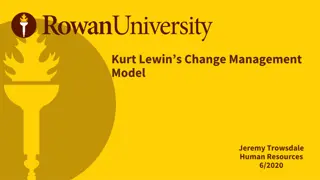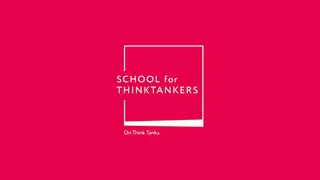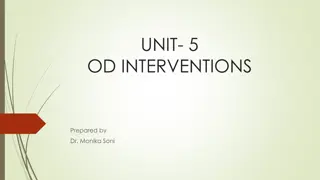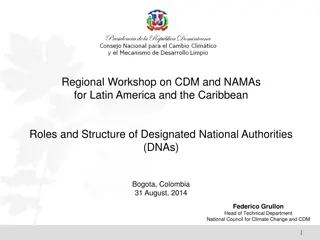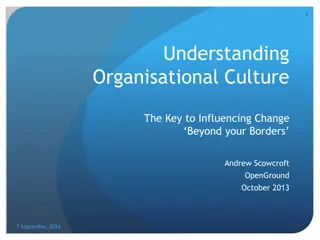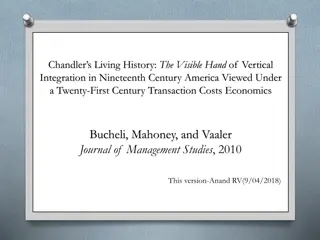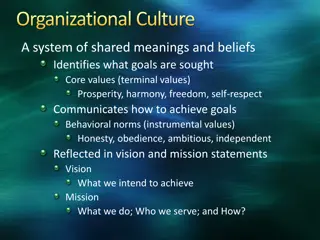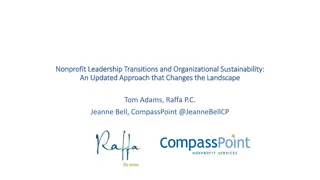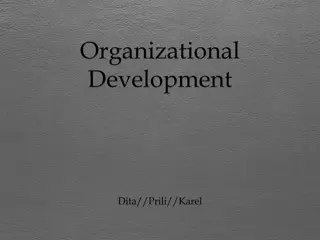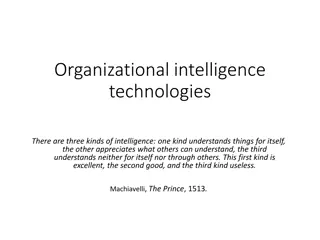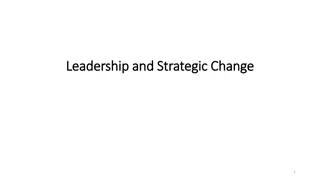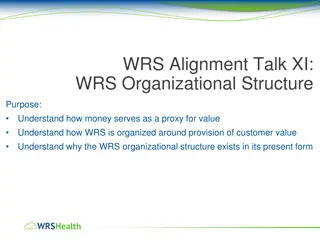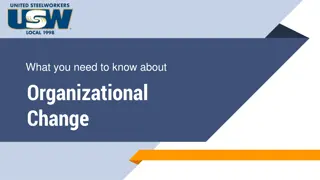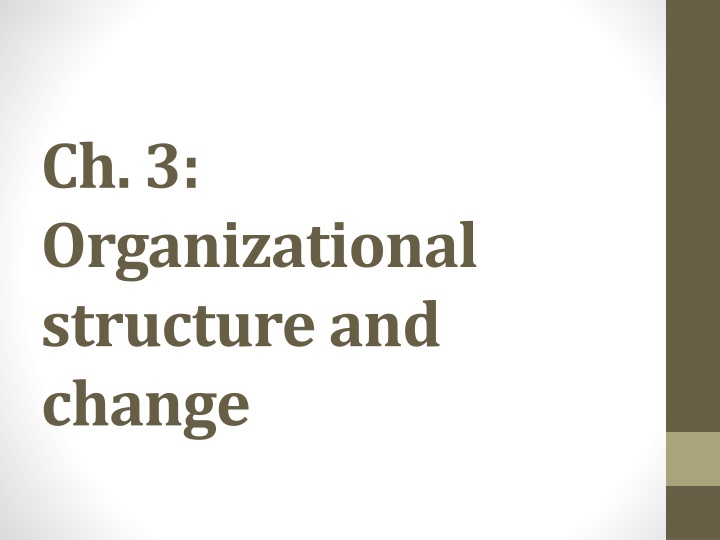
Organizational Structure and Change
Organizational structure is the established pattern of relationships within an organization that outlines communication, control, and authority patterns. It plays a crucial role in linking departments and jobs to achieve organizational goals. Specialization, standardization, formalization, centralization, and configuration are key dimensions of structure that influence how activities are structured, authority is concentrated, and workflow is controlled. Different models of structure like bureaucratic, flatter, multifunctional, and matrix structures offer various ways to organize an organization. Understanding and adapting these structures are essential for effective organizational functioning and adaptation to change.
Download Presentation

Please find below an Image/Link to download the presentation.
The content on the website is provided AS IS for your information and personal use only. It may not be sold, licensed, or shared on other websites without obtaining consent from the author. If you encounter any issues during the download, it is possible that the publisher has removed the file from their server.
You are allowed to download the files provided on this website for personal or commercial use, subject to the condition that they are used lawfully. All files are the property of their respective owners.
The content on the website is provided AS IS for your information and personal use only. It may not be sold, licensed, or shared on other websites without obtaining consent from the author.
E N D
Presentation Transcript
Ch. 3: Organizational structure and change
3.1 The meaning of organization structure Organization's structure: The established pattern of relationships between the component part of an organization, outlining both communication, control and authority patterns. Structure distinguishes the parts of an organization and delineates the relationship between them. Organizational design is the process of constructing and adjusting an organization's structure to achieve its goals. Organizational structure is the linking of departments and jobs within an organization
3.2 The dimensions of structure Specialization Standardization Formalization Centralization Configuration Traditionalism Four underlying dimensions: Structuring of activities Concentration of authority Line control of workflow Support component
3.2 The dimensions of structure 1. Specialization: the extent to which there are different specialist roles and how they are distributed. Standardization: the extent to which an organization uses regularly occurring procedures that are supported by bureaucratic procedures of invariable rules and processes. Formalization :the extent to which written rules, procedures, instructions and communications are set out for employees. Centralization : the extent to which authority to make decisions lies with the apex (top) of the organization. Decentralization refers to attempts to push decision making down to lower levels in the hierarchy. Configuration : the shape and pattern of authority relationships; how many layers there are and the number of people who typically report to a supervisor. Traditionalism : how many procedures are understood in contrast to being written; how commonly accepted is the notion of the way things are done around this organization. 2. 3. 4. 5. 6.
3.2 The dimensions of structure It is clear from this that structure is a multi-dimensional concept such that organizations can be structured in many different ways according to where they fit on the dimensions above Every organization has a unique structural finger-print. There is also evidence to show that some types of structures are a better fit with environments than others
3.3 Models of structure 1. 2. 3. 4. 5. 6. Bureaucratic structure Flatter structure Multifunctional structure Multidivisional structure Matrix structure New organizational form (structures) : Networks Internal networks Vertical networks Dynamic, loosely coupled networks The virtual organization
3.3 Models of structure 1-Bureaucratic structure (sociologist: Max Weber who is the founding father of the organization theory) consist of hierarchies with many levels of management and are driven by a top-down, or command and control approach in which managers provide considerable direction and have considerable control over others. Bureaucratic structures have a certain degree of standardization. They are better suited for more complex or larger scale organizations. They usually adopt a tall structure. It is very much complex and useful for hierarchical structures organization
3.3 Models of structure 2- Flatter structure: Figure3.1 demonstrates how widening the span of control (the number of people reporting to a supervisor) Reduces the number of levels in the structure, while retaining the same number of staff Figure3.2 shows how flattering the structure through doubling the span of control removes over half of the management positions while saving the lower level positions.
Figure 3.1 Flattening the structure but retaining the people Source: Mullins, L.J. (2005) Management and Organisational Behaviour (7th edn), Harlow: Financial Times/Prentice Hall, p. 612
Figure 3.2 Flattening the structure but saving the people Source: Robbins, S.P. (2003) Organizational Behavior (10th edn), Englewood Cliffs, NJ: Pearson Education Limited, pp. 433, 419
3.3 Models of structure 3- Multifunctional structure: An organization s reporting relationships are grouped based on specialty, or functional area. For example: there might be separate departments for marketing, counting, and engineering. Generally all the functional heads will report directly to the company president or CEO. Functional structures limit the opportunity for the development of general managers
3.3 Models of structure 4- Multidivisional structure: The multidivisional or divisional organizational structure coordinates the activities of the company's employees who may make and sell numerous products or services across multiple cities, regions, states or countries It built around outputs rather than outputs
3.3 Models of structure 5-Matrix structure: an organizational design that groups people and resources in two ways simultaneously, by function and product A matrix is a rectangular grid that shows a vertical flow of functional responsibility and a horizontal flow of product responsibility The members of the team report to two superiors: the product team manager and the functional manager The team is the building block and principal coordination and integration mechanism
3.3 Models of structure 6. New organizational forms(Networks structure) : Morgan summarizes the nature of the project organization: the organization is much more like a network of interaction than bureaucratic structure Types of Network Structure: Internal networks Vertical networks Dynamic, loosely coupled networks Virtual organization
3.3 Models of structure Types of Network Structure: Internal networks Typical of situations where an organization owns most or all of the assets associated with its business Vertical networks Typical of the situation where the assets are owned by several firms but are dedicated to a particular business (e.g Toyota as core firm)
3.3 Models of structure Dynamic, loosely coupled networks It has pushed the network from the apparent limit of its capabilities Virtual organization It uses information and communication technology to link people, assets and ideas to create and distribute things without having to rely locations
3.4 Structuration theory, actor- networks and institutional theory Structuration theory actor-networks institutional theory
3.5 Influences on structures Direct influences - change in structure: if there is a change in strategy to respond to PETS- factors, the structure has to change to maintain the structure/strategy relationship - Technology: information technology will affect the way in which it is structured - Size: Size determinations are typically based on number of employees. Generally speaking, the larger the organization, the more likely it will be formalized, specialized, standardized, and complex. Additionally, larger organizations typically have a tall structure, with numerous levels in its hierarchy of authority. Large organizations also reap the efficiency advantages of economies of scale. Indirect influences - culture - creativity - politics - leadership
3.5 Influences on structures The consequents of deficient organizational structures (illustration 3.11, p96) - Motivation and moral may be depressed - Decision making may be delayed and lacking in quality - There may be a conflict and a lack of co-ordination - An organization may not respond innovatively to changing circumstances - Costs may be rising rapidly, particularly in the administrative area
3.5 Influences on structures The strategy-structure fit The direction and scope of an organization over the long term: Which achieves advantage for the organization through its configuration of resources within a changing environment, to meet the needs of markets and to fulfill stakeholder expectations Chandler s strategy-structure thesis Structure follows strategy Structural changes occur as a result of strategic changes during the growth of an organization
3.5 Influences on structures Miles and Snow s strategic types Concluded that every organization form is a result of a specific type of strategic behavior Defenders: Organizations which were typical of the period before the 1920s. They have narrow and relatively stable product-market domains. As a result of this, they seldom need to make major adjustments in their technology, structure or methods of operation. They focus on improving the efficiency of their existing operations. limited product/service lines single capital intensive technology functional structures skills in production efficiency, process engineering and cost control
3.5 Influences on structures Prospectors: Are likened to the divisionalised organizations of the 1920s and 1930s which proliferated in the 1950s. They continually search for product and market opportunities and regularly experiment with potential responses to emerging environmental trends. They are often the creators of change and uncertainty to which their competitors must respond. Because of this they are usually not completely efficient. divers product line multiple technologies product or geographically divisionalised structure skills in product research and development, market research and development engineering
3.5 Influences on structures Analyzers: Are said to have the characteristics of the most recent of Chandler s organization forms. They operate in two types of product/market domains. One relatively stable, the other changing. In their stable areas, they operate routinely and efficiently through use of formalized structures and processes. In their more innovatively areas, key managers watch their competitors closely for new ideas and the they rapidly adopt those that appear to be the most promising. limited basic product line search for a small number of related product and/or market opportunities cost-efficient technology for stable products and project technologies for new products mixed structure, and skills in production efficiency, process engineering and marketing
3.5 Influences on structures Reactors: Are those organizations in which strategy environment inconsistency exists or in which strategy, structure, and process are poorly aligned. There is some evidence that in highly regulated industries, Reactors perform less well than the other three types.
3.5 Influences on structures Mintzberg s forces and forms Direction: Can be likened to having a strategic vision . This gives a sense of where the organization must go as an integrated entity Efficiency: Which balances the costs and benefits, the lower the ratio of costs to benefits the higher the efficiency. The force for efficiency tends to encourage standardization and formalization, focusing on rationalization and restructuring or economy Proficiency, That is for carrying out tasks with high level of knowledge and skills Concentration, Which means the opportunity for particular units to concentrate their efforts on serving particular markets. This is necessary in organizations that are diversified in structure
3.5 Influences on structures Innovation Which means the opportunity for particular units to concentrate their efforts in serving particular markets. This is necessary in organizations that are diversified in structure Co-operation and competition Are the forces which Mintzberg calls catalytic . Co-operation describes the pulling together of ideology, that is the culture of norms, beliefs and values that knit a disparate set of people into a harmonious, cooperative entity . Competition describes the pulling apart of politics in the sense of politics as the non- legitimate, technically not sanctioned organization behavior
3.5 Influences on structures The influence of size on structure The bigger the organisation, the more formalisation and role specialisation Size and technology form at least 50% of determinants of structure. The influence of changing technology Woodward studies: Effectiveness is related to the fit between technology and structure Unit/small batch - organic Large batch and mass - mechanistic Process production - organic Perrow studies: Technology has two variables: Task variability (few or many exceptions) Problem analysability (low or high) Each type of technology should be linked to an appropriate structure Cel 1. Mechanistic Cel 2. Mechanistic with organic aspects Cel 3. Organic with mechanistic aspects Cel 4. Loosely organized organic structure.

